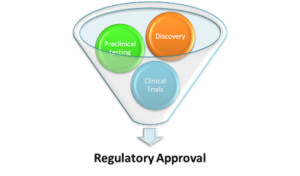When it comes to the world of pharmaceuticals, you may have heard the term “New Chemical Entity” / NCE under Drug Development procedure. But what exactly does this term mean? In this article, we will explore the understanding on NCEs, exploring their significance & understanding their role in the development of innovative medicines.
 |
| Fig.1 : New Chemical Entities (NCEs) |
Defining
NCEs
A
New Chemical Entity; often abbreviated as NCE under the topic drug development,
This term generally used by pharmaceutical community, researchers &
scientists for a novel compound or molecule that has never been used in a drug
before. In simpler word an NCE is a brand new chemical substance that could
potentially be the key to developing ground-breaking pharmaceuticals.
What US FDA Says?
A New chemical entity means a drug that contains no active moiety that has been approved by FDA in any other application submitted under section 505(b) of the Act. (Source)
What CDSCO Says?
“New
chemical entity” means any substance that has not been approved for marketing
as a drug by a drug regulatory authority of any country including the
authorities specified under these rules and is proposed to be developed as a
new drug for the first time by establishing its safety and efficacy. (Source)
What ICH Says?
In ICH Q6, New Chemical Entity is defined under the word “New drug substance” and says The designated therapeutic moiety, which has not previously been registered in a region or Member State (also referred to as a new molecular entity or new chemical entity). It may be a complex, simple ester, or salt of a previously approved drug substance (Source)
The
Significance of NCEs
NCEs are the lifeblood of the pharmaceutical industry. They represent the starting point for drug discovery and development. Without the creation of new and unique chemical entities, the industry would stagnate, and we would be unable to address new and emerging health challenges.
Here are a few key points that
highlight the significance of NCEs:
 |
| Fig.: 2 The Significance of NCEs |
Innovation: NCEs represent innovation at its core. They
allow pharmaceutical companies to develop drugs that can treat diseases more
effectively or even cure them. These new compounds can provide safer, more
potent & more targeted treatments, improving the overall quality of patient
care.
Patent Protection: When a pharmaceutical company discovers and
patents a new chemical entity, they are granted exclusive rights for drug
development, to develop and market drugs based on that compound. This patent
protection can last for many years, allowing companies to recoup their research
and development costs and encourage continued investment in drug discovery.
Competitive Edge: NCEs provide a competitive edge in the market.
Companies that can bring innovative new drugs to market have a distinct
advantage over their competitors. These new drugs can attract more patients,
doctors, and insurers, which can be a game-changer in a highly competitive
industry.
Addressing Unmet Needs: NCEs often cover the way for addressing unmet
medical needs. They can target diseases and conditions for which there are
currently no effective treatments, offering hope to patients who may have
limited or no options for relief.
Economic Impact: The pharmaceutical industry plays a vital role
in the global economy. The drug discovery and drug development of NCEs lead to
job creation, investment in research and development, and revenue generation.
They contribute significantly to economic growth.
The
NCE Development Process
Developing an NCE is a complex and
lengthy process. It typically involves several stages, including:
Discovery:- Drug discovery is like searching for hidden treasures in the vast landscape of science. Researchers and Scientists identifies potential new compounds through extensive research & experimentation. This stage can take years of trial and error. which is termed as R&D. They test many ideas and substances to see which ones can help fight diseases.
Preclinical Testing: Promising compounds are subjected to rigorous testing in laboratories and animal models to assess their safety, efficacy, and potential side effects. The insights gleaned during preclinical testing serve as the foundation upon which the edifice of subsequent clinical trials is built, ultimately determining whether a therapeutic breakthrough will progress towards benefiting human health.
Clinical Trials: If a compound passes preclinical
testing, it moves on to human clinical trials. These trials involve testing the
compound’s safety and effectiveness in humans through a series of carefully
controlled studies. It’s like a
carefully planned journey to find out if a new idea or a special medicine can
really help people get better.
These trials are essential in making sure that
only safe and effective treatments make their way to all of us. It’s like
exploring new possibilities in medicine, and each person who participates
becomes a hero in the quest for better health for everyone.
Regulatory Approval: If the clinical trials are
successful, the pharmaceutical company can submit the data to regulatory
authorities, such as the FDA in the United States. If approved, the NCE can
then be marketed and distributed to the public. regulatory approval for New
Chemical Entities (NCEs) is like securing a golden ticket for a new player in
the pharmaceutical game.
It’s like passing a tough exam – rigorous but
necessary for the greater good. Once you get the green light, your innovation
can step into the limelight and potentially change lives.
In Brief…..
New Chemical Entities are the foundation of
pharmaceutical innovationt.
They open doors to new & improved treatments, drive economic growth, and
provide hope to patients worldwide. The process of discovering and developing
NCEs is challenging, It requires intensive resources, but the rewards are
immense. As we continue to see breakthroughs in drug development, the role of
NCEs remains critical in shaping the future of healthcare.
Learn More….
Clinical Trials: A Key to Pharmaceutical Development / Advancement
The Evolution of Drug Substance Development
Drug Substance in Pharmaceuticals!! Unveiling Its Vital Role
Drug Substance and Drug Product Manufacturing Flow: Discovery to Delivery


